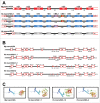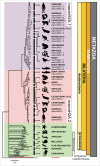The characterization of macroH2A beyond vertebrates supports an ancestral origin and conserved role for histone variants in chromatin
- PMID: 27082816
- PMCID: PMC4939916
- DOI: 10.1080/15592294.2016.1172161
The characterization of macroH2A beyond vertebrates supports an ancestral origin and conserved role for histone variants in chromatin
Abstract
Histone variants play a critical role in chromatin structure and epigenetic regulation. These "deviant" proteins have been historically considered as the evolutionary descendants of ancestral canonical histones, helping specialize the nucleosome structure during eukaryotic evolution. Such view is now challenged by 2 major observations: first, canonical histones present extremely unique features not shared with any other genes; second, histone variants are widespread across many eukaryotic groups. The present work further supports the ancestral nature of histone variants by providing the first in vivo characterization of a functional macroH2A histone (a variant long defined as a specific refinement of vertebrate chromatin) in a non-vertebrate organism (the mussel Mytilus) revealing its recruitment into heterochromatic fractions of actively proliferating tissues. Combined with in silico analyses of genomic data, these results provide evidence for the widespread presence of macroH2A in metazoan animals, as well as in the holozoan Capsaspora, supporting an evolutionary origin for this histone variant lineage before the radiation of Filozoans (including Filasterea, Choanoflagellata and Metazoa). Overall, the results presented in this work help configure a new evolutionary scenario in which histone variants, rather than modern "deviants" of canonical histones, would constitute ancient components of eukaryotic chromatin.
Keywords: Chromatin; In Vivo; epigenetics; evolution; function; histone variants; metazoans; nucleosome; structure.
Figures






References
-
- Bonisch C, Hake SB. Histone H2A variants in nucleosomes and chromatin: more or less stable? Nucleic Acids Res 2012; 40:10719-41; PMID:23002134; http://dx.doi.org/10.1093/nar/gks865 - DOI - PMC - PubMed
-
- Ausió J, Abbott DW. The many tales of a tail: carboxyl-terminal tail heterogeneity specializes histone H2A variants for defined chromatin function. Biochemistry 2002; 41:5945-9; PMID:11993987; http://dx.doi.org/152934010.1021/bi020059d - DOI - PubMed
-
- Pehrson JR, Fried VA. MacroH2A, a core histone containing a large nonhistone region. Science 1992; 257:1398-400; PMID:1529340; http://dx.doi.org/10.1126/science.1529340 - DOI - PubMed
-
- Costanzi C, Pehrson JR. Histone macroH2A1 is concentrated in the inactive X chromosome of female mammals. Nature 1998; 393:599-601; PMID:9634239; http://dx.doi.org/10.1038/31275 - DOI - PubMed
-
- Costanzi C, Pehrson JR. MACROH2A2, a new member of the MARCOH2A core histone family. J Biol Chem 2001; 276:21776-84; PMID:11262398; http://dx.doi.org/10.1074/jbc.M010919200 - DOI - PubMed
Publication types
MeSH terms
Substances
LinkOut - more resources
Full Text Sources
Other Literature Sources
